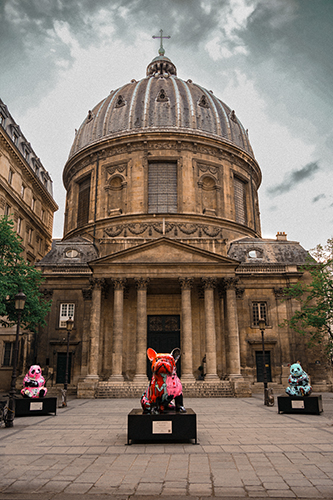OPEN-AIR TOTEMS BY JULIEN MARINETTI
In collaboration with the Comité du Faubourg Saint-Honoré.
From 27 April to 4 June 2021, the artist Julien Marinetti is exhibiting his monumental works on the Place de la Concorde, Rue Royale and Place Maurice Barrès in Paris.
At a time when art galleries and museums are closed, the artist invites you, through his four pictorial totems, to reflect on the current challenges facing us and to contemplate what he likes to call the “syncretism of Art”, i.e. a complete three-dimensional work, at once sculpture, painting and engraving.
Chat Bastet
200 x 140 x 110cm
Bronze and acrylic, engraved, painted and lacquered
Place de la concorde
CHAT BASTET – In front of the Luxor obelisk stands the sculpture in homage to the daughter of the god Ra, “Bastet”, a deity as discreet as she is important in the Egyptian pantheon. Goddess of maternity and fertility, protector of pregnant women and children, this majestic and powerful female figure of Antiquity reminds us that despite her nature, Bastet remains a feline goddess. Capable of going from true gentleness to great cruelty when her anger is aroused: the cat becomes a lioness. This bronze totem, engraved and then painted, wants to teach us patience and courage. The harmony between the shadow and the light…a time for action, another for observation.
–
Teddy
200 x 160 x 140cm
Bronze and acrylic, engraved, painted and lacquered
Rue Royale
TEDDY – CHILDHOOD – “Wisdom sends us back to childhood” said Blaise Pascal. Behind the reassuring and regressive figure of the Teddy Bear, Julien Marinetti invites us to remember the child we were, and to this candid wisdom sometimes lost but often found with time. An anecdote tells that the president of the United States, Theodore Roosevelt, nicknamed “Teddy”, refused to kill an old bear wounded during a hunting trip in Mississippi in 1902, judging the act unsportsmanlike and cruel. This story was immortalised and caricatured in the press as “Teddy’s Bear”. A year later, in 1903, two Russian immigrants created the famous teddy bear named “Teddy”. The bear symbolises the warrior spirit with unshakeable courage and calls for a fight, even in the most difficult situations. The work is located in the Rue Royale above the Eglise de la Madeleine, a Greek temple dedicated to the glory of Napoleon I’s Grande Armée in 1806.
–
Bâ le Panda
150 x 115 x 135cm
Bronze and acrylic, engraved, painted and lacquered
Place Maurice Barrès
PANDA BA – A symbol of gentleness and strength, the Panda is an endangered species. By titling his work “Panda Ba”: (bā) meaning the number 8, a symbol of good luck in China, the artist wants to alert us to the condition of this animal and, in all derision, asserts that we must now rely on luck to hope for a better future for our planet.
In front of the Church of Notre-Dame-de-l’Assomption – Place Maurice Barrès, the artist wanted to exhibit a pair of pandas, highlighting the sacred nature of their reproduction. The work “Panda Ba” was first imagined as a special commission for the city of Singapore.
Doggy John
175 x 115 x 157cm
Bronze and acrylic, engraved, painted and lacquered
Place Maurice Barrès
DOGGY JOHN – On the Place Maurice-Barrès, we find the artist’s iconic piece, a modern-day sphinx contemplating the world. In the form of a French bulldog, representing love, protection and loyalty to his master, hides an acerbic and uncompromising view of his contemporaries. It was in 1998 that the artist imagined his famous Doggy John, first in oil on canvas before freeing himself from the dimensions of painting to take on the round shapes offered by sculpture. Julien Marinetti gave birth to what he would later call the “syncretism of Art”, which is a combination of painting, engraving and sculpture. “The dog is the catalyst of my syncretism of art, that is to say of its totality. What I do is indeed syncretism because there is painting, sculpture and engraving. There are also varnishes, lacquers: I touch on quite a few things that normally have nothing to do with each other. “Julien Marinetti likes to think of the copyist monks of the Middle Ages, whose palimpsests also required them to recondition the original medium by scratching out old parchments.
Sculptures’s photos / © Humbert Deschamps
Julien Marinetti is a painter, sculptor and engraver. Born in 1967 in Paris, he grew up in the Saint-Germain-Des-Prés district, where art and crafts were booming. He creates instinctive, unstructured works close to Picasso. After years devoted to oil and acrylic painting, Julien Marinetti tried his hand at sculpture. His pictorial work then took a new turn. The artist exhibited his first realistic bronze sculpture, the iconic bulldog “Doggy John”. He emancipated himself, sculpture became the privileged support of his own painting: from this fusion, he created what he calls “Art Syncretism”. The painter has always pointed out that the traditional canvas is not a two-dimensional but a three-dimensional medium because of its composition. It is therefore logical that he has thought of his surfaces in successive planes, and associated the flat areas in layers and lacquered varnishes, appropriating in a very personal way the technique of chromatic composition by penetrating planes by playing with the lines of rupture suggested by the black lines giving rhythm to the juxtaposition of colours. Today, the painter is exclusively presenting his monumental totem works, inspired by the Neo-Cubist movement. A close look at his works reveals compositions in which the artist, inspired by the Great Masters of the beginning of the last century: Kasimir Malevitch, Pablo Picasso, Joan Miró, Henri Matisse and Fernand Leger.
–
In collaboration with the Comité du Faubourg Saint-Honoré.

